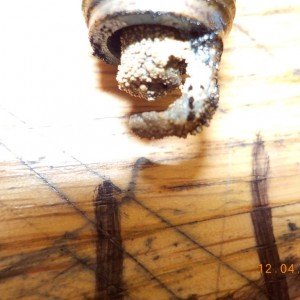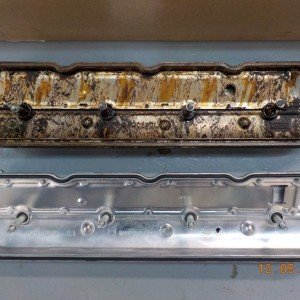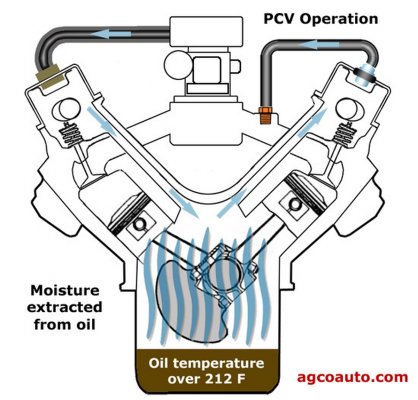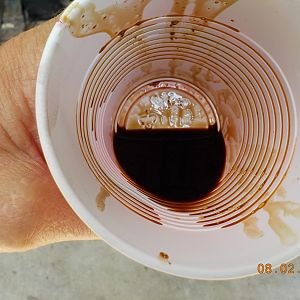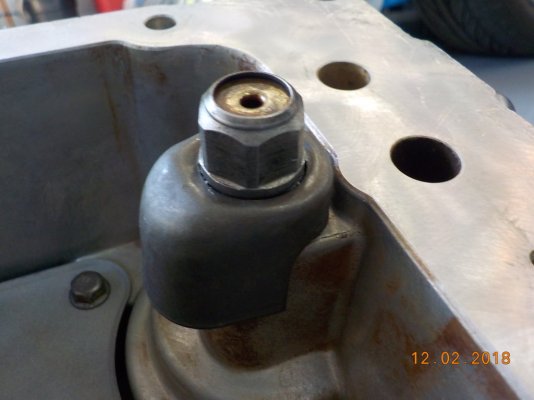Owned since new and all stock and all service is documented.
Regarding the undated replacement valve cover. How does the revised baffle affect oil consumption?
The only real difference is the location of the hole in the baffle. Yes, the revised hole is not only in another location but it's also square and larger. I'm not sure why. Could be simple ease of manufacturing or maybe the size plays a role in air volume and/or liquid oil drainage. As I understand it, the original location was inline with oil being flicked off of a rocker arm, so it had liquid oil being thrown into the baffle that couldn't drain off quickly enough. The oil filled up behind the baffle and flowed to the back (due to acceleration and installed angle of engine) where it was sucked up through the PCV port.
What is the purpose and the "why" of the oil catch can? Is the intention to collect oil before it gets to the valve cover? If that is the case then it is still oil consumption assuming that caught oil is disposed of, no? Am I assuming the wrong function?
LS engines have strong PCV flow volume. Especially at higher loads/higher RPM, they move a lot of oil through the air stream. If they're driven easily/normally, the amount of oil passed and burnt usually isn't much of a concern. A catch can catches [most of] the oil carried in the PCV stream and collects it in a reservoir rather than letting it go into the engine. It's the oil
leaving the valve cover and going
into the intake manifold. The can't cause harm, so having one even if there's not much oil present is one of those "safer than sorry" measures. Oil making its way out of the engine is one thing. But being
consumed by the engine is another, and worse thing. Burning the oil is what can eventually cause problems and has. If the oil in the can is clean, and it will be assuming there's not a lot of moisture in there with the oil, then you can dump it back into the engine through the oil fill neck. The first measure is to keep it inside the engine in the first place, and that updated valve cover is the first step.
What you describe as oil potentially draining into the rear two cylinders from the intake manifold; Might that situation be looked into by looking at the spark plugs and if needed a step further using a scope?
@donjetman got you lined out. He has one of the most comprehensive success stories of the problem, cause and resolution I've seen. You can remove the #7 #5 plugs and compare. Ideally, they look the same. If #7 has more carbon on it, then that cylinder as a whole is crudded up. I'd attack the source(s) and perform the upper engine soak(s), etc. just as Don did.
About turning off the AFM, other than effect on gas mileage, are there any other implications of doing that?
I presume that the ECM had to be sent away so there is down time for the truck and possibly worse if the shipments get mishandled or lost. Do you know if there is a "plug in" reprogrammer for DIYers?
Another thought is that our state is a stickler with emissions and routinely checks our vehicles plugging them into inspection station scanners. Do you know if the alteration is picked up as having an impact on emissions? Increasing gas usage might be construed in that manner.
These engines were bombproof in their Gen 3 form. Gen 4 brought better components, but also the first iteration of AFM, making that legendary reliability questionable. Lose AFM and you then should have that Gen 3 reliability and then some due to the upgraded parts. No adverse affects other than losing a miniscule amount of fuel economy.
The thing is, what little MPG gain this version of AFM may yield will NEVER be worth the risk of running it. There are too many factors needed for AFM to be engaged and you'd have to remain in those instances for extended periods for it to be worth even considering keeping. I'm talking cruising at a steady speed under 65, maybe 70 on flat land with no curves, no traffic, no head- or sidewinds, etc. for miles and miles at a time. And this needs to be your everyday route/use. Anything outside of that and AFM is deactivated. At best, on a road trip, you're saving maybe $2 per tank of fuel. How much of that would you need to just break even with the cost of an engine rebuild or replacement? Yes, there are plug-in modules to disable AFM. There are cheap ones on Amazon and ebay that seem to work fine, but might draw power even when the car is off, leading to a dead battery. The king of these modules is Range. I think even they have or had the battery drain issue with their earlier versions and might have fixed it by now. Still, I'd unplug it if the car was gonna sit for more than a day or two. What I don't like about these plug-in modules is you have to babysit them- remember to plug it in, remember to unplug it. You also have your ALDL ("OBDII") port occupied. If you're somewhere requiring inspections or if you bring your car in for service and they need to access the port, they have to unplug it. When unplugged, the readiness monitors aren't set, so you can't pass inspection at that time or it might confuse the serviced tech thinking you have more issues than you/they thought. When unplugged, you're re-enabling electrical and mechanical components that haven't been cycled in X amount of time. This has been known to cause mechanical failure. For these reasons, I'd rather disable it via tune. It's like AFM just isn't a feature on the engine any longer and it operates normally otherwise. That place I linked you to seems to have great service. I know of two or three members here that have used them just within the past year or two. Yes, there is down time and yes, there is a risk of the PCM being lost in shipping. These are valid concerns. Another option, and it might be worth the extra cost to you, is to have someone locally tune your car to turn it off. Credits to license a PCM are $100. So, it's that plus what they charge for their labor. Just to turn things off should command the bare minimum since they're not datalogging, tweaking fuel and spark maps, etc. I had mine tuned not long after I bought it to disable AFM, turn off the rear O2 sensors, remove the speed limiter and maybe something else I'm not remembering. It was $150. Or, if you've ever entertained a full tune, which I'd recommend, you can have them turn off AFM when that is done. Full tunes are easily $500+ for a reputable, trustworthy tuner. I don't believe AFM existence or usage is monitored with normal emissions inspections. But, a modified tune, at any level, might be, depending on where you live. I'd venture to say this would only be a problem in California.
